A lot of mythology surrounds the oak wilt disease that’s so common in our region. Arborist Mark Peterson sets the record straight.
During the last millennium, because of my experience in Dutch elm disease management, I was hired by the Texas Forest Service, (currently Texas A&M Forest Service) to assist in addressing the state’s oak wilt infestation.
For those new to Texas, oak wilt is a disease that has killed hundreds of thousands of oaks, mostly in the central portion of the state.
I soon discovered a lot of mythology surrounding the disease and sought to quickly correct those erroneous notions. Flash forward 33 years and I still encounter many of those same errors finding their way into public and private conversations.
Allow me to set the record straight.

Myth No. 1: Oak wilt is a virus, blight, decline or something unknown.
Wrong. We know exactly what oak wilt is: Oak wilt is a vascular fungus that invades the water-conducting tissue of the tree.
Myth No. 2: Oak wilt is spread by burning oak firewood.
Absolutely not!
Heat above 95 degrees kills oak wilt fungus. However, firewood that is cut in the fall from infected red oaks and left unused until spring may form a type of fungus that attracts small beetles called nitidulid beetles; they may then spread the spores to fresh wounds on healthy oaks.
Myth No. 3: It’s hopeless. All the oaks will die.
Poppycock!
Live oaks retain a natural survival rate of about 20 percent and white oaks have a survival rate of over 90 percent. It’s a basic fact of this disease that it’s extremely inefficient in starting new infection centers. How it even exists in Texas has been a question that intrigued forest pathologists for years.
Myth No. 4: Red oaks should be banned to stop the spread of oak wilt.
Red oaks are not the problem. True, infected red oaks may produce fungal mats in the spring and fall. These fungal mats attract beetles with their sweet odor and produce the spores that the beetles can track to fresh wounds on other oaks. However, very few red oaks ever become infected — less than three percent — and the mechanism to attract the insects is extremely weather dependent. Too wet or dry or hot and the fungal mats are not produced. And most importantly, the beetles only fly about ¼ mile in their lifetime.
So what is the problem?
Truth No. 1: The only way to begin a new oak wilt center is by cutting a fresh wound, particularly on the major limbs or trunk.
The beetles are attracted to sap. If they visited a fungal mat on a red oak recently, they may allow the spores to infest the fresh wound on the oak and the tree will become infected. But — and I cannot stress this enough — if a single oak was covered by thousands of nitidulid beetles and those beetles were covered with thousands of spores, the tree would not become infected if there were no fresh wounds. You must have a fresh wound to initiate an infection center.
Truth No. 2: Painting the fresh wound within 30 minutes is 100 percent effective in eliminating infection.
Oil or latex, it doesn’t matter. Just paint.

Truth No. 3: In Texas, the primary spread of oak wilt is through connected roots, between individual red oaks or between groups of live oaks.
While extremely difficult in stony or very deep soils, the spread can be limited or stopped altogether. Effective suppression requires detailed planning and nerves of steel when eliminating apparently “healthy” trees within the treatment area. The Texas A&M Forest Service, in conjunction with the USDA Forest Service, has installed thousands of miles of trench. The success rate has depended on the nature of the land, whether rural or urban, and the aggressiveness of tree removal, both infected and healthy, within the treatment center.
Truth No. 4: The fungicide propiconazole is effective in protecting live oaks.
The chemical, which must be injected into the tree, is extremely effective in killing the fungus. However, getting it into the tree is difficult and selecting the right tree for injection is very painful to some homeowners. On many residences, only 1 in 7 trees are candidates for injection. With regards to oak wilt, triage is very important for successful injection.

Truth No. 5: The spread of oak wilt has been reduced.
Through 30-plus years of information dissemination, legislation and active suppression, the rate of new centers has been greatly reduced. A recent review of the oak wilt centers in Bexar County concluded about 85-90 percent of centers were the same ones I catalogued in the mid-90s. This is not to say the centers themselves have not stopped expanding. Many continue to spread to this day.
Truth No. 6: Diversity produces stability.
The greater the species diversity, the less likely oak wilt exists. The nitidulid beetle is not attracted to oaks exclusively. Therefore, the more tree and shrub species the less likely an infested beetle will land on an oak fresh wound and the likelihood drops to insignificant levels.

Truth No. 7: “We have met the enemy and he is us.”
The comic strip character Pogo issued these immortal words back in 1970. With respect to oak wilt, that is the most important truth. We have encouraged the creation of live oak monocultures at the detriment of other species. We create fresh wounds in abundance with utility crews, backhoes, bulldozers and chainsaws. We fail to paint faithfully. Oak wilt would not be a problem if only we thought proactively.
I hope I’ve eliminated some of the oak wilt myths today. Now, paint those wounds and plant non-susceptible species this fall. I have never lost sleep over oak wilt and neither should you.





